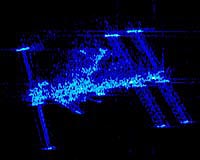 |
Tucson AZ (SPX) Mar 26, 2010 When astronauts aboard the Space Shuttle Endeavor docked with the International Space Station on Feb. 10, more than 200 miles above the Atlantic west of Portugal, part of their mission was to collect a sample from an experiment conducted by University of Arizona College of Engineering researchers. The small ingot of aluminum-silicon alloy was the first material sample supporting U.S. research to be processed in NASA's Materials Science Research Rack on the orbiting space station. The rack is fixed to the outside of the station and suspended in open space. Professors David Poirier and Robert Erdmann of the UA's department of materials science and engineering, and Surendra Tewari of Cleveland State University, are researching how molten metals solidify in zero gravity and will study the sample. After Endeavour landed on Feb. 21, the sample was taken to NASA's Marshall Space Flight Center in Huntsville, Ala., for initial examination. It will then will be taken to Cleveland State University for additional testing. Poirier and his team are studying a process known as directional solidification. "The model alloy under study by the U.S. investigators is an aluminum-silicon alloy, closely related to alloys used to produce castings," said Poirier. "The main focus is to study the role of zero gravity on the solidified microstructures that result from directional solidification, and to compare the microstructures with samples made under similar conditions on Earth." NASA researcher Frank Szofran added that because there is no buoyancy in space, materials can be developed that have a stronger or more regular structure. "Understanding this structure can help to produce stronger materials on the Earth," Szofran said. "In addition to learning about the underlying science of alloy solidification, the space experiments are particularly relevant to the manufacture of alloys used in the high-temperature gas turbines that power aircraft and produce electric power," Poirier said. The knowledge gained from this research could help the casting industry improve processing and eliminate defects. The European Space Agency developed the space station's onboard Materials Science Laboratory, which contains NASA's Materials Science Research Rack. The rack includes a furnace that was used to process the metal ingot. U.S. investigators have samples processed in the facility and collaborate with European science teams, which are currently examining the first two samples brought home from the space station. The Materials Science Research Rack was added to the space station at the end of 2009 and includes a furnace in which samples can be processed at temperatures of up to 2,500 degrees Fahrenheit. Members of the space station crew insert samples in the furnace one at a time, and the experiment is run from Earth by automated command. The research rack is about the size of a large refrigerator, measuring 6 feet high, 3.5 feet wide and 40 inches deep. It weighs about 1 ton. Development of the research rack was a cooperative effort between the Marshall Center and the European Space Agency. Et CeteraContact Info
Share This Article With Planet Earth
Related Links University of Arizona Station at NASA Station and More at Roscosmos S.P. Korolev RSC Energia Watch NASA TV via Space.TV Space Station News at Space-Travel.Com
 Italian Astronaut To Test Electronic Nose On ISS
Italian Astronaut To Test Electronic Nose On ISSPerugia, Italy (RIA Novosti) Mar 25, 2010 Italian astronaut Roberto Vittori, who is due to fly to the International Space Station (ISS), will test an Italian-designed sensor, a national news agency reported on Tuesday. Ansa said the 'electronic nose', selected for the mission by the Italian Space Agency and NASA, is a highly sophisticated device able to detect various odors. "The sensor is designed to identify numerous scent ... read more |
|
| The content herein, unless otherwise known to be public domain, are Copyright 1995-2010 - SpaceDaily. AFP and UPI Wire Stories are copyright Agence France-Presse and United Press International. ESA Portal Reports are copyright European Space Agency. All NASA sourced material is public domain. Additional copyrights may apply in whole or part to other bona fide parties. Advertising does not imply endorsement,agreement or approval of any opinions, statements or information provided by SpaceDaily on any Web page published or hosted by SpaceDaily. Privacy Statement |